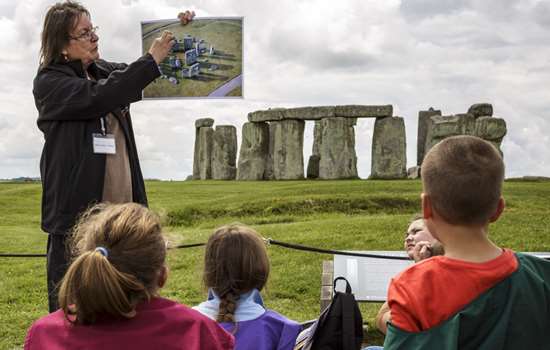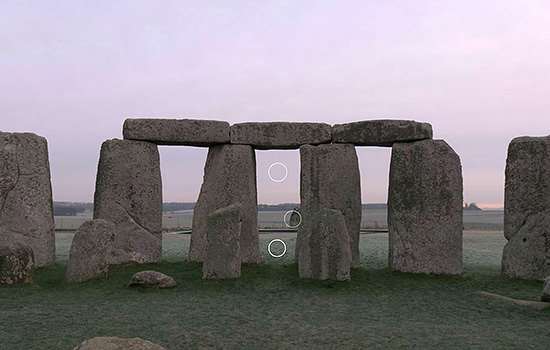Curriculum Links
Support your teaching in the classroom by stepping out of it. A visit to Stonehenge will help you bring learning to life, covering multiple topics across the curriculum and key stages.
- KS1 History: Significant historical events, people and places in their own locality
- KS1 Geography: Geographical skills and fieldwork
- KS2 History: A local history study. Changes in Britain from the Stone Age to the Iron Age
- KS2 Geography: Geographical skills and fieldwork: use fieldwork to observe, measure, record and present human and physical features in the local area. Human geography: types of settlement and land use
- KS3 History: A local history study. A study of an aspect or theme in British history that consolidates and extends pupils’ chronological knowledge from before 1066
- KS3 Geography: Human geography: understand how human and physical processes interact to influence and change landscapes and environments
- KS4 History: OCR Specification B 2c. Introduction to history around us
- KS4-5 Business/Leisure and Tourism: Heritage Management
Free Self-Led Visits
Studying late Neolithic hunter gatherers and Bronze Age religion? We challenge you to find a better site to help you cover the topic than the world famous Stonehenge. It’s a unique opportunity, whatever your area of study, for your class to explore the most outstanding prehistoric monument in the British Isles. Enjoy a free self-led visit and explore the site your way.
Download the Teachers' Kit below for information and activities to help you discover the story of Stonehenge, or use these resources available online:
- Education Film, by students from Wiltshire College
- Education Partners of Stonehenge
- Education Game: can your class successfully build Stonehenge?
Expert-led Discovery Visits
Sandford Award winner 2021!
Let us help you inspire your students with our hands-on, award-winning expert-led Discovery Visits. Available Tuesday-Thursday, they're great value for up to 30 students.
Find out morePlan your trip
We have a wide range of materials to support your visit and make school trip planning easy. You can find all our site-specific information and tools below, and further information on our what to expect page.
Download our free resources to help you make the most out of your visit and create unique learning experiences before, during and after your trip. We also offer free planning visits once you have made a booking, plus a 20% discount on the official English Heritage guidebook for your place of choice.
Once you book your visit you’ll be sent a visit permit, which you’ll need to bring with you on the day.
Visit our bookings page to start planning your trip!
Learning Resources
-

Stonehenge Teachers' Kit (KS1-KS4+)
Our Teachers’ Kits feature historical information and activity suggestions for group leaders of various subjects and key stages.
-

Stonehenge OCR Spec B: History Around Us (GCSE)
We’ve created a site proposal form to help with your planning in conjunction with OCR.
-

Stonehenge Teachers' Kit (Czech)
A Czech translation of our Stonehenge Teachers' Kit.
-

Stonehenge Teachers' Kit (French)
A French translation of our Stonehenge Teachers' Kit.
-

Stonehenge Teachers' Kit (German)
A German translation of our Stonehenge Teachers' Kit.
-

Teaching Prehistory
Use historical information, learning activities and tips from our historians, curators and educational experts to support your prehistory teaching.
-

Stonehenge: Stand or Fall? Game
Can you raise Stonehenge or will it fall? Try building Stonehenge with our interactive game.
-

Virtual Tour of Stonehenge
Explore the key features of Stonehenge with this 360 degree virtual tour from inside the monument.
-

Learn: Celebrating Solstice at Stonehenge
Use our guide to celebrating solstice to find out more about what a solstice is, why it happens, and how Stonehenge aligns with the sun.
-
Maggie Aderin-Pocock Explains the Solstice
Join space scientist Maggie Aderin-Pocock as she explains what the solstice is and why it happens.
-

Skyscape
Take a look at the live view from within the stones and learn about the movements of the sun, moon and planets.
-
A Mini Guide to Prehistoric Monuments
Use this short animation to better understand how and why prehistoric monuments were built.
-
How was Stonehenge Created?
Learn more about how Stonehenge was built in this short animation.
-
What Happened in the Neolithic?
Find out more about life and developments during the Neolithic period with this animation.
-
How to Make Prehistoric Pottery
Join ancient pottery specialist, Graham Taylor, as he explains how Grooved Ware was made.
-
Enquire now
0370 333 1181
-
Visit our bookings page to start your enquiry. All bookings must be made at least 14 days in advance. Please make sure you check our terms and conditions ahead of your visit.
If you’d like more information about a site or one of our workshops, get in touch using the online form on our bookings page to speak to your local Education Visits Officer. We look forward to seeing you soon.

